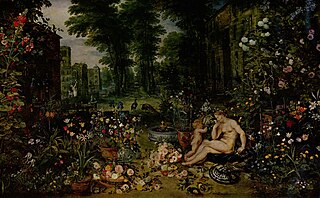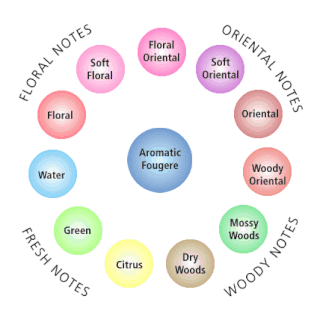Related Research Articles
Perfume is a mixture of fragrant essential oils or aroma compounds (fragrances), fixatives and solvents, usually in liquid form, used to give the human body, animals, food, objects, and living-spaces an agreeable scent. Perfumes can be defined as substances that emit and diffuse a pleasant and fragrant odor. They consist of manmade mixtures of aromatic chemicals and essential oils. The 1939 Nobel Laureate for Chemistry, Leopold Ružička stated in 1945 that "right from the earliest days of scientific chemistry up to the present time, perfumes have substantially contributed to the development of organic chemistry as regards methods, systematic classification, and theory."

An essential oil is a concentrated hydrophobic liquid containing volatile chemical compounds from plants. Essential oils are also known as volatile oils, ethereal oils, aetheroleum, or simply as the oil of the plant from which they were extracted, such as oil of clove. An essential oil is essential in the sense that it contains the essence of the plant's fragrance—the characteristic fragrance of the plant from which it is derived. The term "essential" used here does not mean indispensable or usable by the human body, as with the terms essential amino acid or essential fatty acid, which are so called because they are nutritionally required by a living organism.

The olfactory system or sense of smell is the sensory system used for smelling (olfaction). Olfaction is one of the special senses, that have directly associated specific organs. Most mammals and reptiles have a main olfactory system and an accessory olfactory system. The main olfactory system detects airborne substances, while the accessory system senses fluid-phase stimuli.
Smell-O-Vision is a system that released odour during the projection of a film so that the viewer could "smell" what was happening in the movie. Created by Hans Laube, the technique made its only appearance in the 1960 film Scent of Mystery, produced by Mike Todd Jr., son of film producer Mike Todd. The process injected 30 odors into a movie theater's seats when triggered by the film's soundtrack.

An aroma compound, also known as an odorant, aroma, fragrance or flavoring, is a chemical compound that has a smell or odor. For an individual chemical or class of chemical compounds to impart a smell or fragrance, it must be sufficiently volatile for transmission via the air to the olfactory system in the upper part of the nose. As examples, various fragrant fruits have diverse aroma compounds, particularly strawberries which are commercially cultivated to have appealing aromas, and contain several hundred aroma compounds.
Fragrance oils, also known as aroma oils, aromatic oils, and flavor oils, are blended synthetic aroma compounds or natural essential oils that are diluted with a carrier like propylene glycol, vegetable oil, or mineral oil.

Rose oil is the essential oil extracted from the petals of various types of rose. Rose ottos are extracted through steam distillation, while rose absolutes are obtained through solvent extraction, the absolute being used more commonly in perfumery. The production technique originated in Greater Iran. Even with their high price and the advent of organic synthesis, rose oils are still perhaps the most widely used essential oil in perfumery.

Eau de toilette is a lightly scented perfume. It is also referred to as aromatic waters and has a high alcohol content. It is usually applied directly to the skin after bathing or shaving. It is traditionally composed of alcohol and various volatile oils. Traditionally these products were named after a principal ingredient; some being geranium water, lavender water, lilac water, violet water, spirit of myrcia and 'eau de Bretfeld'. Because of this, eau de toilette was sometimes referred to as "toilet water".

Rachel Sarah Herz is a Canadian and American psychologist and cognitive neuroscientist, recognized for her research on the psychology of smell.

Sandalwood oil is an essential oil obtained from the steam distillation of chips and billets cut from the heartwood of various species of sandalwood trees, mainly Santalum album and Santalum spicatum.

An odor or odour is caused by one or more volatilized chemical compounds that are generally found in low concentrations that humans and many animals can perceive via their sense of smell. An odor is also called a "smell" or a "scent", which can refer to either an unpleasant or a pleasant odor.

The sense of smell, or olfaction, is the special sense through which smells are perceived. The sense of smell has many functions, including detecting desirable foods, hazards, and pheromones, and plays a role in taste.

Aromatherapy is a practice based on the use of aromatic materials, including essential oils and other aroma compounds, with claims for improving psychological well-being. It is offered as a complementary therapy or as a form of alternative medicine. Fragrances used in aromatherapy are not approved as prescription drugs in the United States.

Digital scent technology is the engineering discipline dealing with olfactory representation. It is a technology to sense, transmit and receive scent-enabled digital media. The sensing part of this technology works by using olfactometers and electronic noses.

A fragrance wheel , also known as aroma wheel, fragrance circle, perfume wheel or smell wheel, is a circular diagram showing the inferred relationships among olfactory groups based upon similarities and differences in their odor. The groups bordering one another are implied to share common olfactory characteristics. Fragrance wheel is frequently used as a classification tool in oenology and perfumery.
Sensory branding is a type of marketing that appeals to all the senses in relation to the brand. It uses the senses to relate with customers on an emotional level. It is believed that the difference between an ordinary product and a captivating product is emotion. When emotion flows in the marketplace, your product shines. When there is no emotion from the product, customers lack the enthusiasm and passion that launches a product to success. Brands can forge emotional associations in the customers' minds by appealing to their senses. A multi-sensory brand experience generates certain beliefs, feelings, thoughts and opinions to create a brandgon image in the consumer's mind.

Bergamot essential oil is a cold-pressed essential oil produced by cells inside the rind of a bergamot orange fruit. It is a common flavoring and top note in perfumes. The scent of bergamot essential oil is similar to a sweet light orange peel oil with a floral note.
Beard oil is a cosmetic product that is used to nourish both the skin under the beard and the beard itself in order to keep it "soft, shiny, and smooth". Beard oil mimics the natural oils produced by skin, such as sebum, and is composed mainly of carrier oils and essential oils.

Olfactic communication is a channel of nonverbal communication referring to the various ways people and animals communicate and engage in social interaction through their sense of smell. Our human olfactory sense is one of the most phylogenetically primitive and emotionally intimate of the five senses; the sensation of smell is thought to be the most matured and developed human sense.
References
- 1 2 3 C. X. Wang, Sh. L. Chen, Aromachology and its Application in the Textile Field, http://www.fibtex.lodz.pl/54_14_41.pdf
- ↑ Celia Lyttleton, The Scent Trail, (2007), ISBN 978-0-85750-031-1
- ↑ "Aromachology". Archived from the original on 2011-09-28. Retrieved 2011-08-25.
- 1 2 3 Maria Lis-Balchin, Aromatherapy Science: a Guide for Healthcare Professionals, p. 3, (2006), ISBN 0-85369-578-4
- 1 2 "Aromachology? (The consumer counts: fragrance)." Home Accents Today, May 2003, p. 34. General OneFile, http://link.galegroup.com/apps/doc/A102520043/ITOF?u=miam11506&sid=ITOF&xid=f0f92b9d. Accessed 21 Oct. 2018.
- ↑ Maria Lis-Balchin, Aromatherapy Science: A Guide for Healthcare Professionals, page 3, 2006, Pharmaceutical Press, Publications Division of the Royal Pharmaceutical Society of Great Britain, ISBN 0-85369-578-4.
- 1 2 Warda, R. (2002). "Aromatherapy vs. Aromachology: the difference between natural essential oils and synthetic fragrances can mean the difference in offering consumers true aromatherapeutic benefits". Global Cosmetic Industry (11): 58.
- 1 2 Rottman, T. R. (1989). The effects of ambient odor on the cognitive performance, mood, and activation, of low and high impulsive individuals in a naturally arousing situation. Diss. Abstr. Int. 50:365B 1989
- 1 2 谷田正弘, 菊池晶夫, 上野山重治, 阿部恒之, 山口浩, Tanida, M., … Yamaguchi, H. (1992). アロマコロジーの化粧品への応用 (1) 香りが反応予期事態の心拍変動パターンに対して及ぼす影響. 日本化粧品技術者会誌, 26(2), 113–119. doi : 10.5107/sccj.26.113
- ↑ "Limbic System: Amygdala (Section 4, Chapter 6) Neuroscience Online: An Electronic Textbook for the Neurosciences | Department of Neurobiology and Anatomy - The University of Texas Medical School at Houston". nba.uth.tmc.edu. Retrieved 2022-05-24.
- ↑ "Brain Processes Sense of Smell Better Than Previously Thought" "Science Daily", April 30, 2007, retrieved 2009-12-3
- ↑ Subramaniam, Vanmala (2010-03-17). "Aromachology: A scent of their own".
- ↑ Staff, W. W. D. (1999-10-29). "SHISEIDO'S ANTI-AGING SOLUTION". WWD. Retrieved 2022-05-24.
- ↑ Damian, Kate, Aromatherapy: Scent and Psyche, page 120, 1995, Healing Arts Press, USA, ISBN 0-89281-530-2
- ↑ Raudenbush, B., Corley, N., & Eppich, W., Pages 156-160. Augmenting athletic performance through the administration of peppermint odor. Journal of Sport & Exercise Psychology, 23,(2001)
- 1 2 Kempski, Diotoma von, Page 63, "The Use of Olfactory Stimulants to Improve Air Quality", Journal of the Human Environmental System, Vol 5; No.2 61-68, 2002
- ↑ McCooey, Christopher, Scenting Success, Financial Times, Feb 02 2008, retrieved 2009-10-03
- ↑ Andrews, Linda, The Hidden Force of Fragrance. In: Psychology Today, November, 2007, Retrieved 2024-03-13